Seasons End: More Than Suitcases – Tamara Henderson
Gallery 1, Douglas Hyde Gallery, Trinity College Dublin
*****
To visit Tamara Henderson’s immersive installation at the Douglas Hyde is like wandering into a busy souk, a crowded, colourful marketplace. The gallery’s cavernous concrete box has elicited some spirited responses from exhibitors over the years, and Henderson’s is up there with the best of them – that is, with the best of those that opt to transform the space rather than go with the grain. Henderson’s transformation is radical: a maximalist approach to a minimalist cube.
Vast sewn fabric drapes play an essential role, enclosing and defining an environment that leads visitors via winding, labyrinthine paths through a world teeming with looming anthropomorphic figures, much more celebratory than threatening. These hybridised creatures, amalgamations of scarecrow, mannequin and ritual effigy, are rooted in comically outsize feet – or boots. There are some witty sculptural flourishes, in the descriptions of heads, say, but fabric is what they are all about, displayed, gathered, sewn, patch-worked, embroidered and painted (extremely well in each case). Henderson works collaboratively, and here she credits Aude Levère for costume design and production, plus Jake Tilbury, Dan Riley (sound), and Nectar Efkarpidis.
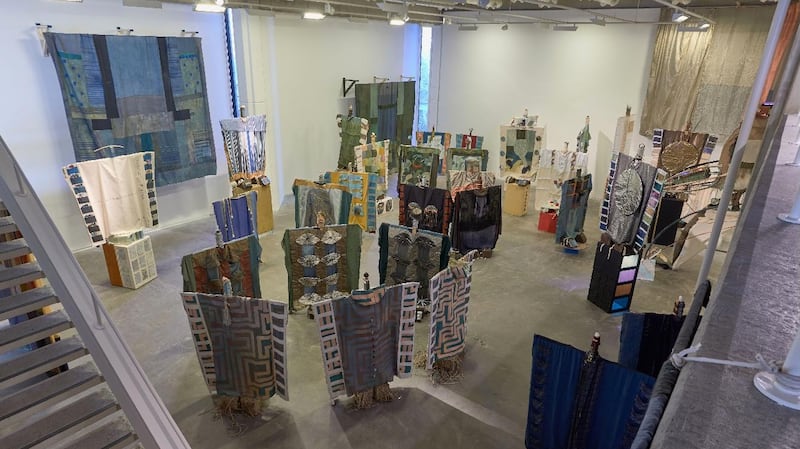
Born in Canada, in Sackville, New Brunswick, Henderson is based in London. She studied first in Canada, then at the prestigious Städelschule in Frankfurt and finally in Sweden. Her work suggests a great deal of travel, and the fabrics employed here – they are superb and provide a continual, dazzling wealth of colour, texture and pattern – were acquired on the road, including in Turkey and at markets in Athens. Restlessness is built into the concept of Seasons End, which began with a residency at Hospitalfield in Scotland in 2015 and first materialised at the Glasgow International 2016.
It is an evolving, travelling project that seems to have quickly gathered momentum. Judging by the documentation of previous incarnations, it is not too rash to suggest that this incarnation in the Douglas Hyde may be the best, and the biggest, so far. It unites two groups of 25 figures from previous stages and there is a winning generosity – not unakin to monomania, it’s true – in its unstinting inventiveness and exhaustive detail: no matter how carefully and methodically you make your way through it, you will not pick up on everything. This cumulative feeling of being in the thick of it is essential to its atmospheric intensity, undercutting the habitual, distancing sense of looking at an exhibition.
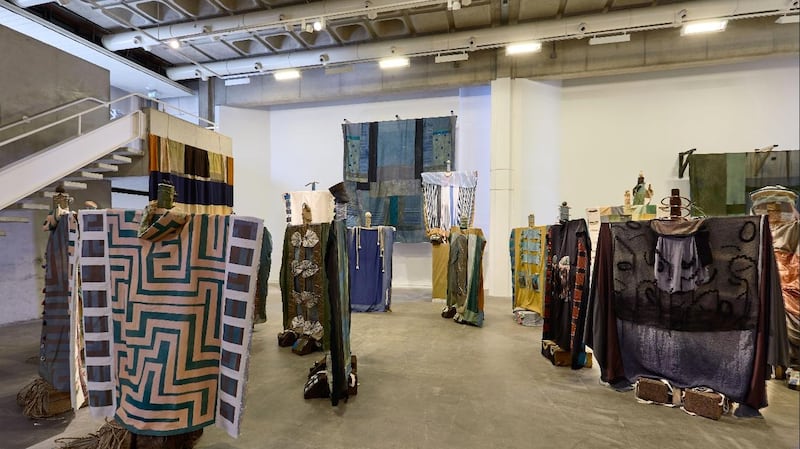
Each figure is individually characterised, from Editor in Suitcase to Silverfish in Tuxedo to Eye Witness and Doc. Many are laden with informative props and images. A once-dominant presence, the Garden Photographer, succumbed along the way, but her ashes are installed in the mechanical, breathing Bar of Body high on a wall of the gallery. Ideas of movement, mortality, death, birth, rebirth, different states of consciousness, myths and dreams are pervasive. References to various texts, including The Tibetan Book of the Dead, works on spirituality, and practical accounts of aspects of the natural world confirm that Henderson mines a rich vein of untethered, free-wheeling, countercultural energy.
Until May 5th, douglashydegallery.com
Illusions of Love Dyed by Sunset: Bassam Al Sabah
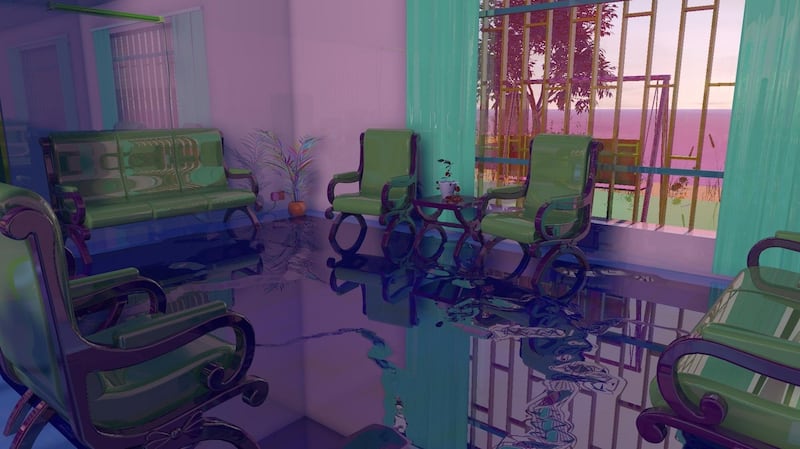
The Lab Gallery, Foley Street, Dublin
*****
In looking back to the Iraq that he left when he was 10, and to his own childhood, Bassam Al Sabah takes an untypical, even disconcerting path. He lights on the several Japanese cartoon series, dubbed into a generic Arabic, that were broadcast across the Middle East from the 1980s. These anime tales of superheroes and fantastic feats were, surprisingly enough, a universal background entertainment for generations. The introductory presentation could be tweaked in different locations, he notes, but the staple narratives always involved a dauntingly powerful, invading outsider. Leading the defence was the Grendizer, a super-robot being.
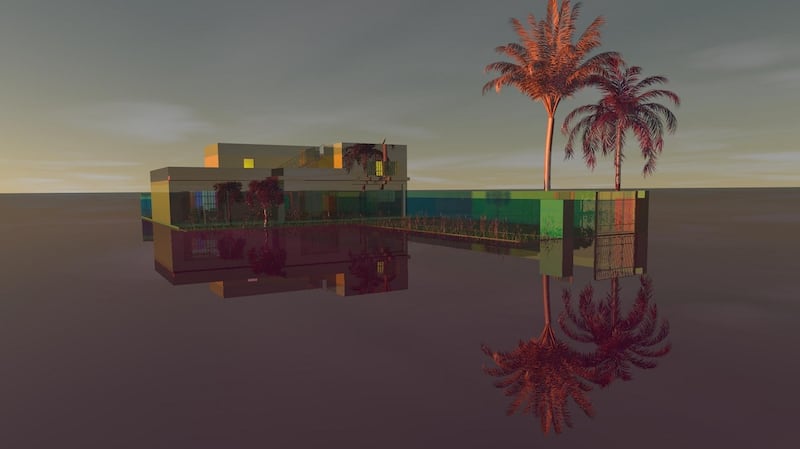
Enmeshed with this fictional wallpaper (and the introductory piece is almost literally that: digital images of anime characters printed on to a swathe of fabric suspended on a double-height wall) is the reality of his own family, including his parents, sister and grandmother. In a series of painted, sculptural and video pieces he explores this conjunction of imagination and fact filtered through memory. Painted recreations of family snapshots are encased in blocks of perspex, preserved but remote. The Grendizer is usually, sometimes comically neutralised and diminished, a once-futuristic hero whose glossy patina has faded and whose powers proved to be illusory. In one case the character, fashioned in clay, is shattered, echoing images of destroyed antiquities.
Magical plants sprout and flourish and fade. One enfolds, as if protectively, tiny silver sculptures of Al Sabah’s mother’s face. As it happens, plants are central to his recollections of place. At the heart of the show is a projected CGI animation. Al Sabah created a three-dimensional model of the family home in Iraq. The camera leads us into and around this simulated house and something odd starts to happen: digital streams of information and imagery start to coil uncontrollably out of the radio, the television and computer monitors, enveloping the interior and threatening to obliterate it.
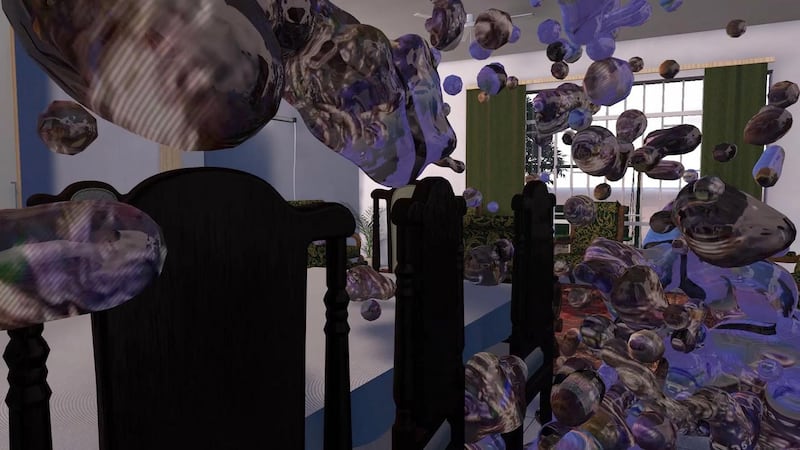
It is a straightforward idea and extremely effective. Then our tour of this lost place concludes with an elegiac sequence. As the family prepared to leave forever, Al Salah’s grandmother had to choose which of her possessions she would bring. Horrified at the thought of leaving the remainder to be looted and destroyed, she built a bonfire and burned them.
Until June 3rd, dublincityartsoffice.ie/the-lab


















